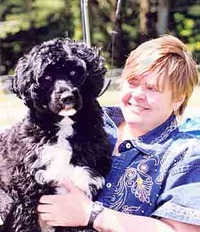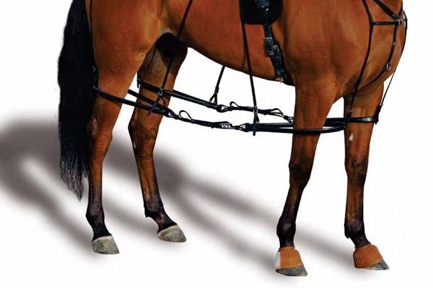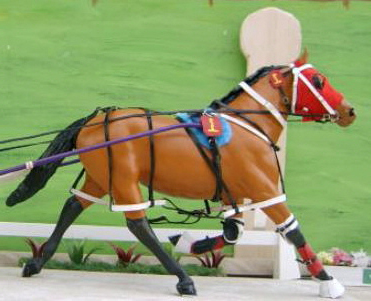Course Details
What's in there anyway? Little wheels? Why is one dog graceful and another one clumsy? What's a fiddle front and why should you care? Will that puppy grow out of those cow hocks? Why DOES that dog walk sideways all the time? And why do little injuries always seem to happen on the front end?
Most dog sports people don't think of the structure of a dog at all - either when they're picking out the dog that's going to be living and working with them for the next 10 to 15 years, or when they're picking what sports are reasonable for that dog to play in. "Oh," they think, "that's for those dog show people!"
That's too bad. Structure affects movement, and movement affects everything your dog does every day, let alone the sports you want to play with her. Structure affects how much muscle she'll build, how fast she'll be, what tight turns she'll be able to make, and her risk of injury.
Come join us on an adventure into the structure of our canine companions!
 Instructor: Sue Ailsby
Instructor: Sue AilsbySusan Finlay Ailsby (she/her) has retired from active teaching for FDSA. She is a retired obedience and conformation judge. She has been "in dogs" for 54 years, having owned and trained Chihuahuas, miniature pinschers, miniature longhaired dachshunds, Australian cattle dogs, miniature schnauzers, giant schnauzers, and Portuguese...(Click here for full bio and to view Sue's self-study courses)
Syllabus
WEEK ONE: Getting under the skin
- Long Bones, The Head, Spine, Cables & Pulleys, Feet - what they are and what they do.
WEEK TWO: Rears from the back
- how they're built, how they move, and what can go wrong.
WEEK THREE: Fronts from the front
- how they're built, how they move, and what can go wrong.
WEEK FOUR: Rears from the side
- yep, how they're built, how they move, and what can go wrong.
WEEK FIVE: Fronts from the side
- how they're built, how they move, and what can go wrong.
WEEK SIX: Back Bone's connected to the Front Bone...
- what happens when you expect it all to play nicely together.
Please note that, for an in-depth look at muscles, I recommend Debbie Gross' classes here at Fenzi.
Prerequisites & Supplies
PREREQUISITES:
You're welcome to take this class without a dog, but having your own hands-on model of the lectures and videos will definitely make things clearer for you. If you have a choice of dogs, pick the one that's easiest to handle, as there will be a fair amount of poking and prodding going on during the class. Of course, you can also use your handy local llama, horse, sheep, or goat. Birds won't help you much.
EQUIPMENT:
Treats to reward the poke-and-proddee are not out of the question.
A videocamera of some variety - a dedicated camera, a tablet, a smartphone. I recommend you videotape (or whatever the digital equivalent is) your own dog as you learn. Video gives your eyes a second, third, fourth opportunity to compare the real world to what you're seeing in class videos.
Space to walk and trot your dog in a straight line - an aisle or hallway at least 15 feet (5 metres) long, or an equivalent space outside.
Paper and pen.
Sample Lecture
GAITS
Remember when I asked you to draw the bendy parts on your dog? Some of you could do it, some of you had never looked at them before. How the dog moves will be the same - some of you know it, and some have seen it but never thought about it before.
At first glance, dog movement comes in "walking" and "running" but we need to be a lot more specific.
Before we start, we need to know one thing. Moving has two parts - GAIT and SPEED. These frequently go together, but they don't always. Watch the first 2 minutes of the following video. The same GAIT (it's a trot, but we'll get to that in a minute) is used throughout those 2 minutes, but the horse goes forward at many different SPEEDS.
Now let's look at GAITS.
WALK - obviously, the first one. Sedate, relaxed. Walking takes very little energy since there are 3 feet on the ground at all times. When your dog is "walking" around your house, she is, indeed, walking. I always think that it looks like the dog's right back leg moves forward and then pushes the right front leg forward. Then the left back leg moves and pushes the left front forward.
PACE - as the dog goes faster, having three feet on the ground starts holding her back so she gets a little better coordinated using the same motion of having the left legs move forward together and then the right legs. Sled dog teams use the pace as a resting gait in the middle of races because it has two feet on the ground all the time but can move them along at a pretty good speed. In a pace, the right back foot and right front foot take off and land at the same time, as do the left feet. While you're watching the video, notice how Syn's ribcage swings back and forth as she paces. That's because it's supported on one side or the other.
If you're having trouble remembering what a pace looks like, consider pacing racehorses, which frequently wear hobbles so their right legs cannot move separately as they would in a trot (next).


TROT - this is the standard show gait. In a trot, diagonal legs move forward together - that is, left rear and right front. It's easier for me, however, to think of legs on the same side moving apart and together. With real solid support under the dog's torso, there is no swinging from side to side. The topline is strong and level. There are 2 feet on the ground 90% of the time.
Getting back to the idea of speed not equalling gait, take a look at the trots of Syn (brown) and Stitch (black). Syn has plenty of angulation front and back and takes large, smooth strides. Stitch is old and has little angulation and less reach or drive. Rather than being smooth, her strides are short and choppy. When Syn is still walking, Stitch has to trot to keep up. Now go back to the first video in this lecture and watch the horse's legs as it TROTS.
GALLOP - that's easy, right? Galloping is running. Well, not quite so simple.
Most of us kids pretended we were horses, "galloping" around the lawn.
This kid is on her LEFT lead. That means her RIGHT leg lands first, but her LEFT leg is mostly out in front. Try this yourself. On your left lead, it's easy to turn to your left but scary trying to turn to your right. Now try it on your RIGHT lead with your right leg out in front. Turn a right circle, then turn a left. Those of you in agility know that a dog is always running in a circle with you at the centre. It could be a tight circle, or it could be a big loose circle, but if the dog is running this circle with you on her left, she's on her LEFT lead:

and if she's running clockwise around you with you on her right, like this:

she's on her RIGHT lead. And now you know about leads.
Other than the left and right LEADS, here are two categories of gallop, with different styles in each.
First, the pattern of footfalls:
*TRANSVERSE GALLOP - this is the "regular" gallop - the horse gallop. Once you know the pace, you can see how easy it would be to transition from a walk to a pace to a gallop, since all three gaits have the legs on the right side going back and forth together, and the same for the left. In the transverse gallop, the dog's front AND back end are both on the same lead.
*ROTARY GALLOP - this one seems to be a deep dark secret. It took me years of asking other presenters, horse people, and vets about "why my dogs run funny" before I got a name for this and was able to research it better. In the rotary gallop, the dog's front end and back end are on different leads.
The rotary gallop is a NORMAL gait for predators, including dogs. Your dog will likely use a rotary gallop at least half the time, and change back and forth between transverse and rotary on a random basis.
Even though the rotary gallop is arguably the fastest gallop, for horses, the rotary gallop (AKA "disunited gallop") happens rarely because the horse isn't built for it, and when it does happen, it's a sin because it's difficult and uncomfortable to ride.
Second, how much time is spent in the air:
*ZERO SUSPENSION GALLOP - giraffes, being very large and pretty darn delicate, always have one foot on the ground, even when they're galloping. Giraffes go THROUGH lions, not OVER them!
*SINGLE SUSPENSION GALLOP - big dogs, short dogs, heavy dogs - indeed, most dogs - do a single suspension gallop. That means that there are four footfalls and then a "mighty leap" where there are no feet on the ground at all.
In the next video, note that a jump is nothing more than a bigger, broader single suspension.
*DOUBLE SUSPENSION GALLOP - this is the famous sight hound gait. They have the standard mighty leap with the legs stretched forward and back, but they also have a distinct moment of free flight with the front legs back and the back legs forward:
*AMBLE - Amble is often called a pace by dog people, but it's really closer to a walk. It's faster than a walk, and that can make it difficult to see that the right back foot is landing BEFORE the right front foot, not at the same time. This is a very common gait for big dogs such as Mastiffs, and it's a gait that's correct for Old English Sheepdogs (though never seen in the show ring any more). Rumour has it that "all" dogs amble on occasion, but I only have three at my disposal. The Giant Schnauzer puppy is either trying to catch birds out of the sky or rolling in the snow. My old Portuguese Water Dog only remembers how to trot, and my middle-aged PWD is one of those rare dogs who actually paces, so we're going to look at elephants:
*STOTT - Because you deserve it, let me introduce you to the STOTT, a guardy or joyful gait used occasionally by llamas, and often by some African gazelles:
Finally, a quick video of Syn demonstrating some of the previously-discussed gaits.
Testimonials & Reviews
A SAMPLING OF WHAT PRIOR STUDENTS HAVE SAID ABOUT THIS COURSE ...
I thinkThis course was amazing. I learned loads and Sue Ailsby is a wonderful teacher. I had taken other courses and read books about structure in the past but I learned so much more. A wonderful experience! My only regret was that with so much info (and the holidays in between) time really flew, I wished the course was longer! (Serena M)
Sue has such in-depth knowledge and a magical way of sharing it so that we can begin to see structure and movement through her eyes. So many tools to take away. I'll never look at any dog (or llama) in the same way again
The structure and movement course was an excellent companion course to the canine fitness courses I am taking. Really enjoyed the content, the way the course has been presented and the tempo. Very nice!
I find myself evaluating all dogs I see regarding their structure. I learned so much and it was nice to see the Silver and Gold members posts to help in the learning process. I will take more classes in the future. Pam E.
Words cannot express how helpful I find Sue's marked-up video stills and drawn-on pictures -- I'm sure they must take a while to do, but SO. INCREDIBLY. HELPFUL.
I thought it was just wonderful! Exceeded my expectations :)
Sue Ailsby is amazing and she is so funny - her humour and writing talent really helped me understand the lectures and piqued my interest, whereas I would normally fall asleep with such technical subjects! This was my first class with Sue and it has convinced me that I need to take more of her classes - she really knows how to keep students engaged!
Sue has a wealth of knowledge in dog anatomy, and has great ways of communicating information to her students. I have learned SO MUCH! - Helen S.
Sue's knowledge of structure and movement is extraordinary. There was SO MUCH information presented and the discussion forums were fantastic. Sue made the information accessible and applicable.
Registration
This is a self-study class. The lectures will appear directly in your library, under the "Self Study classes" heading. Self Study classes do not have class homework forums. You will not have any access to the course instructor for questions or feedback. Please note there are no refunds on self-study classes so review all the information provided carefully before purchasing.
You will have access to these materials in your library for one year from the date of enrollment. You can keep your library pass current by enrolling in at least one course or workshop a year. Alternatively, you can purchase a library pass for $25 per year for as long as you wish to have access to prior class materials.
FE238 Self Study
FE238: Structure and Movement
CLICK ON THE PURPLE "ENROLL" BUTTON BELOW TO PURCHASE
Find more details, refund policies and answers to common questions in the Help center.